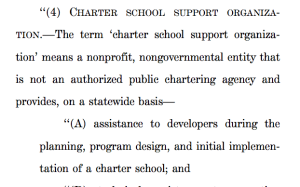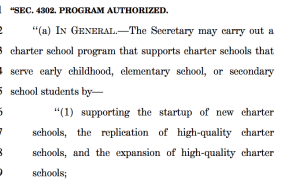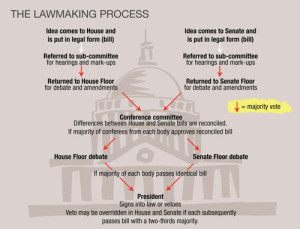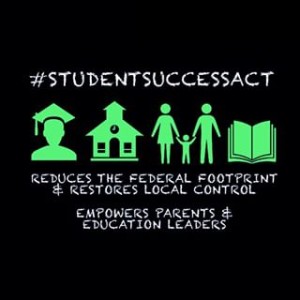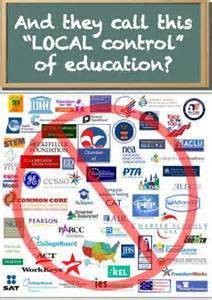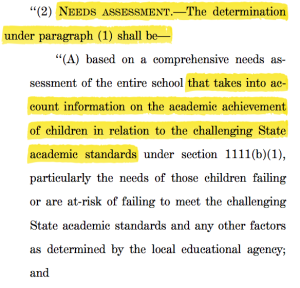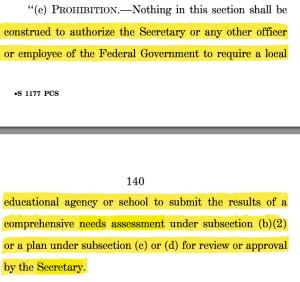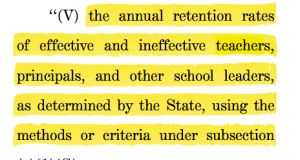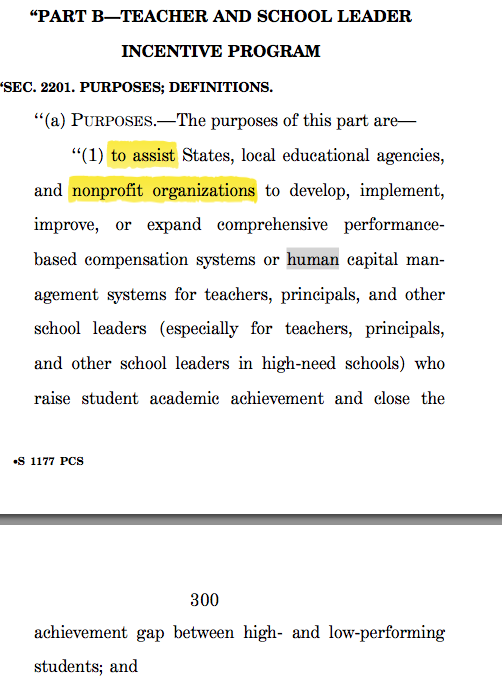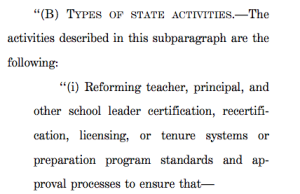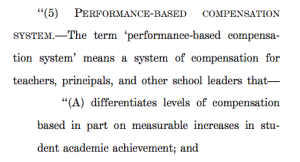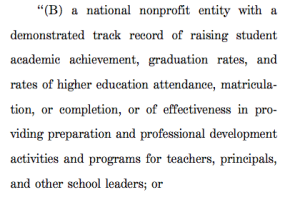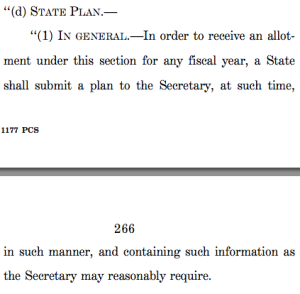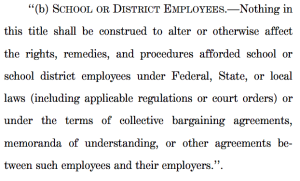When I last posted a blog, I was challenged. The challenge was to THINK…AND DO!
 I responded…
I responded… Well, life doesn’t lend itself well to being put on hold, but I did my best with the time I had and produced an alternative for Congress to consider. The problem is, Congress never wanted to consider any of the good ideas concerning No Child Left Behind that have been put before them over the last 15 years. My last attempt here, I’m calling the People’s Alternative.
Well, life doesn’t lend itself well to being put on hold, but I did my best with the time I had and produced an alternative for Congress to consider. The problem is, Congress never wanted to consider any of the good ideas concerning No Child Left Behind that have been put before them over the last 15 years. My last attempt here, I’m calling the People’s Alternative.
AND I’m passing on Gloria’s challenge to all of you who will accept it – THINK and DO.
~~~~~~~~
The People’s Alternative turns back the clock to a time when ESEA was NOT an attempt to dictate an accountability system from the federal level.
The People’s Alternative offers a federal law that supports children in urban and rural slums in states unable to provide adequate educational resources.
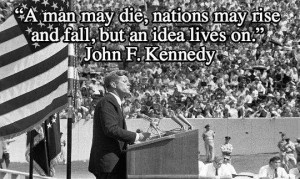
Through the people he brought to D.C., JFK kept ideas alive in a law that he didn’t live to see. – ESEA …Both NCLB & ESSA kill the ideas. Compare.
The People’s Alternative is based on the principles written into law by the architects of the 1965 Elementary and Secondary Education Act with the addition of successful practices from the decades that followed. The law then got RESULTS.
~~~~~~~~
Both No Child Left Behind (NCLB) and the current proposal before congress, “The Every Student Succeeds Act” (ESSA, S.1177), are based on the politically motivated theory known as outcome-based education. They are NOT based on scientifically researched best practices in education.
NCLB mandated a national system of accountability based on State academic standards for reading or language arts and mathematics and the testing annually of all students nation-wide in all public schools to assess “adequate yearly progress” (AYP). It was the largest and longest-lasting experiment in outcome-based (market-based) theory in the history of the United States. The other two periods of testing this theory ended when detrimental results were seen after only a few years.
ESSA is based on the same theory as NCLB only it is executed through a federally approved mandate for state accountability. Compare the descriptions —
“ The statewide accountability system shall be based on the challenging State academic standards for reading or language arts and mathematics to improve student academic achievement and school success. (ESSA, pg.80)”
~~~~~~~~
The People’s Alternative builds on the idea that the local community must have access to information necessary for them to support and improve their own public schools. The Alternative respects the research demonstrating that the local school must be the focus of analysis and intervention to improve student performance. The Alternative supports the continued random use of this nations most respected national test for monitoring the achievement gap. Mandating additional testing, in federal education law, of every pubic school student in every school every year is unnecessary for the federal government to serve its purposes or the purposes as originally laid down in ESEA.
~~~~~~~~
NCLB sold the nation on the idea that yearly standardized testing of all children provided necessary information when in reality the results from the random use of the long-established National Assessment of Educational Progress (NAEP) continues to provide consistent national monitoring of student academic progress.
ESSA continues to see the federal government as the national assessment authority giving the Secretary the power to use federal dollars for State assessment purposes, which in reality are a state financial responsibility.
“The Secretary may provide a State educational agency, or a consortium of State educational agencies with the authority to establish an innovative assessment system (ESSA, pg.222).”
~~~~~~~~
The People’s Alternative designates use of federal education dollars in:
Title I – using a comprehensive needs assessment process, funding is targeted at meeting the identified needs of children from low-income families and other disadvantaged groups, and for the already identified Priority Schools, supplying additional family and community engagement personnel and specialized training for principals, the first year, and other personnel in the following years based on needs.
Title II – establishing summer institutes within existing public institutions of higher education with funding increasing educational opportunities for all education professionals and high-needs service scholarships providing opportunities for experienced education professionals wishing to advance their education to fill identified needs in high demand subjects as well as high-needs schools and locations.
Title III – based upon information gathered during the comprehensive needs assessment process of Title I, funding is to supply student supports that are vital to educational improvement but absent from the community identified as in need, including library resources.
Title IV – funding is to support educational research and the dissemination of scientifically researched practices that have proven to be effective beginning with those necessary for successful implementation of this law.
Title V – to strengthen those state departments of education most in need of helping because the inequality that exists between states is a long-standing problem and funding improvements at that level helps move them closer to fulfilling their responsibility in providing a quality system of public schools.
~~~~~~~~
NCLB funding was money spent on annual standardized achievement testing, accountability mechanisms based on the outcomes of those tests, reporting of compliance with the law, and school choice being offered as a solution — all packaged and sold to the country as “flexibility.”
ESSA funding supports more experimentation with assessment and accountability systems with a new emphasis on “comparability,” as a requirement, as well as offering grants for assessment audits (assessments of how many assessment we are using).
Charter Schools (independent governance with state and federal funds) win out over Magnet Schools (local control) by $270,000,000 to $94,000,000 and states applying for these charter school grants are required to “establish or enhance” a per-pupil state “facilities aid” program. Plus, there are many grants to the “cottage industries” of the charter movement.
Oh, we should not forget preschool charters….
…. and never mind that we can’t control for quality!
And the biggest new federal program in ESSA is the Student Support and Academic Enrichment grant program being sold as “providing greater flexibility to enhance support for students and schools.” There are a number of tempting options offered but it is blended learning, digital learning, and online learning that jumped out at me suggesting that the technology industry may be the big prize winners in this 1.65 BILLION $$$ “enrichment” program.
~~~~~~~~
With the original 1965 ESEA being a mere 35 pages, the NCLB law being 670 pages, and ESSA weighing in at 1,059 pages, there is much, much more that could be said if the country ever desired to have that conversation — and were given the opportunity.
~~~~~~~~
Rise to the Challenge.
Challenge Congress and President Obama to THINK and DO the right thing.
STOP S.1177 The Every Student Succeeds Act (UPDATE: 1/2/ 2019. We did not rise to the challenge, yet. There is hope and opportunity in a new year!)

